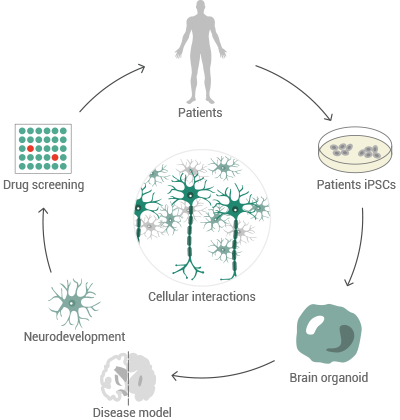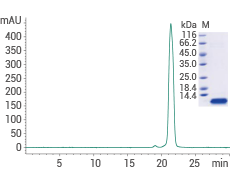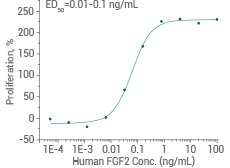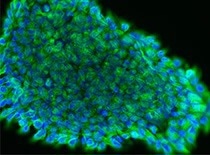Neurodegenerative conditions are debilitating ailments marked by the progressive decline in brain function and impact millions of individuals on a global scale.
As of January 2023, the FDA approved lecanemab, marketed as Leqembi™ by Eisai, as a therapeutic option for Alzheimer’s disease.
This significant milestone represents the second drug approval in this category, with aducanumab, known as Aduhelm™, having received approval in 2021, signifying a notable advancement in immunotherapy for neurodegenerative disorders.
Currently, the primary models utilized for researching brain diseases typically rely on postmortem human brain tissue, non-human primate tissue, or 2D in vitro experiments. However, these approaches are constrained by resource limitations and disparities in brain structure among different species.
In recent times, a hopeful alternative has surfaced in the form of 3D brain organoids, which are cultivated from either embryonic stem cells (ESCs) or induced pluripotent stem cells (iPSCs). These organoids are proving to be a promising model for investigating neurodegenerative diseases.
Organoids derived from various brain regions, such as the forebrain, midbrain, and hippocampus, are cultured and employed as in vitro models for investigating neurobiological and neurodevelopmental disorders. The presence of cytokines in brain organoid cultures is of critical importance.
To illustrate, growth factors like FGF2, EGF, Noggin/NOG, and BMP4 have guided cellular differentiation along specific organ lineages. Furthermore, FGF2, SDF1, and FGF19 are utilized in the cultivation of cerebellar organoids, which are instrumental in the study of conditions like spinocerebellar ataxia.
Sino Biological offers a comprehensive array of products suitable for brain organoid culture, including human EGF, FGF2, NOG, BMP4, FGF8, FGF19, and more. These resources greatly support research efforts focused on neurodegenerative diseases.

Figure 1. Brain organoid: an emerging model for investigating neurological development in vitro. Image Credit: Sino Biological US Inc
Featured cytokines for brain organoid culture
Sino Biological has created an extensive collection of bioactive recombinant cytokines sourced from a diverse range of species, including humans, mice, cynomolgus monkeys, rhesus monkeys, rats, and dogs.
- Various Species
- High Purity
- HPLC Verified
- Low Endotoxin
- High Activity
Human EGF protein, HPLC-verified
(Cat#: 10605-HNAE)

High-purity: ≥ 95 % as determined by SDS-PAGE & SEC-HPLC. Image Credit: Sino Biological US Inc

Activity-validated: Cell proliferation assay using Balb/C 3T3 mouse embryonic fibroblasts. Image Credit: Sino Biological US Inc
Human FGF2 protein
(Cat#: GMP-10014-HNAE)

Activity-validated: Cell proliferation assay using Balb/c 3T3 mouse embryonic fibroblasts. Image Credit: Sino Biological US Inc
Human Noggin/NOG protein, HPLC-verified
(Cat#: 10267-HNAH)

High-purity: ≥ 95 % as determined by SDS-PAGE & SEC-HPLC. Image Credit: Sino Biological US Inc

Activity-validated: Inhibit BMP4-induced alkaline phosphatase production by MC3T3E1 mouse preosteoblast cells. Image Credit: Sino Biological US Inc
Human BMP4 protein
(Cat#: 10609-HNAE2)

Activity-validated: Cell proliferation assay using NIH-3T3 mouse embryonic fibroblast cells. Image Credit: Sino Biological US Inc
More cytokines for brain organoid culture (partial list)
Source: Sino Biological US Inc
| Cytokines |
Product |
Cat# |
Expression Host |
Purity |
Activity |
| EGF |
Human EGF Protein |
GMP-10605-HNAE
(1 Citation)
|
E. coli |
≥ 95 % (SEC-HPLC) |
Active |
| EGF |
Human EGF Protein (hFc Tag) |
10605-H01H
(1 Citation)
|
HEK293 Cells |
> 90 % |
Active |
| EGF |
Mouse EGF Protein (hFc Tag) |
50482-M01H
(4 Citations)
|
HEK293 Cells |
> 95 % |
Active |
| EGF |
Mouse EGF Protein |
50482-MNAY
(1 Citation)
|
Yeast |
> 95 % |
Active |
| EGF |
Feline EGF Protein (hFc Tag) |
62010-U01H |
HEK293 Cells |
> 90 % |
|
| EGF |
Canine EGF Protein (His Tag) |
70013-D07E |
E. coli |
> 98 % |
Active |
| EGF |
Rat EGF Protein |
80446-RNAE |
E. coli |
> 95 % |
Active |
| FGF2 |
Human FGF2 Protein |
10014-HNAE
(30 Citations)
|
E. coli |
> 95 % |
Active |
| FGF2 |
Mouse FGF2 Protein (His Tag) |
50037-M07E
(1 Citation)
|
E. coli |
> 95 % |
Active |
| Noggin/NOG |
Human Noggin Protein (hFc Tag) |
10267-H02H
(1 Citation)
|
HEK293 Cells |
> 95 % |
Active |
| Noggin/NOG |
Human Noggin Protein (His Tag) |
10267-H08H |
HEK293 Cells |
> 95 % |
Active |
| Noggin/NOG |
Mouse Noggin Protein (hFc Tag) |
50688-M02H
(6 Citations)
|
HEK293 Cells |
> 85 % |
Active |
| BMP4 |
Mouse BMP4 Protein (rFc Tag) |
50439-M15H |
HEK293 Cells |
> 92 % |
Active |
| FGF8 |
Human FGF8 Protein |
16124-HNAE |
E. coli |
> 95 % |
Active |
| FGF8 |
Human FGF8 Protein |
16277-HNAE
(2 Citations)
|
E. coli |
> 95 % |
Active |
| FGF19 |
Human FGF19 Protein |
12226-HNAE |
E. coli |
≥ 95 % (SEC-HPLC) |
|
| SDF-1 |
Human SDF-1 Protein (hFc Tag) |
10118-H01H |
HEK293 Cells |
> 95 % |
Active |
| SDF-1 |
Human SDF-1 Protein (His Tag) |
13511-H07E |
E. coli |
> 90 % |
|
| SDF-1 |
Human SDF-1 Protein |
10118-HNAE
(2 Citations)
|
E. coli |
> 95 % |
|
| SDF-1 |
Mouse SDF-1 Protein |
50025-MNAE |
E. coli |
> 95 % |
|
| SDF-1 |
Rhesus SDF-1 Protein |
90009-C02H |
HEK293 Cells |
> 95 % |
Active |
Featured antibodies related to brain organoid culture
Anti-SOX2 antibody
Rabbit mAb; (Cat#: 100106-R017)

Immunochemical staining of human SOX2 in human testis. Applications: IHC-P. Image Credit: Sino Biological US Inc.
Anti-beta-III tubulin/TUBB3 antibody
Rabbit pAb; (Cat#: 101288-T34)

Immunofluorescence staining of TUBB3 in hESC-H9 cells. Applications: WB, ICC/IF. Image Credit: Sino Biological US Inc
Anti-Nestin antibody
Mouse mAb; (Cat#: 103270-MM11)

Flow cytometric analysis of Human NES expression on SHSY5Y cells. Applications: WB, IHC-P, FCM, IP. Image Credit: Sino Biological US Inc
Learn More about Brain Organoids